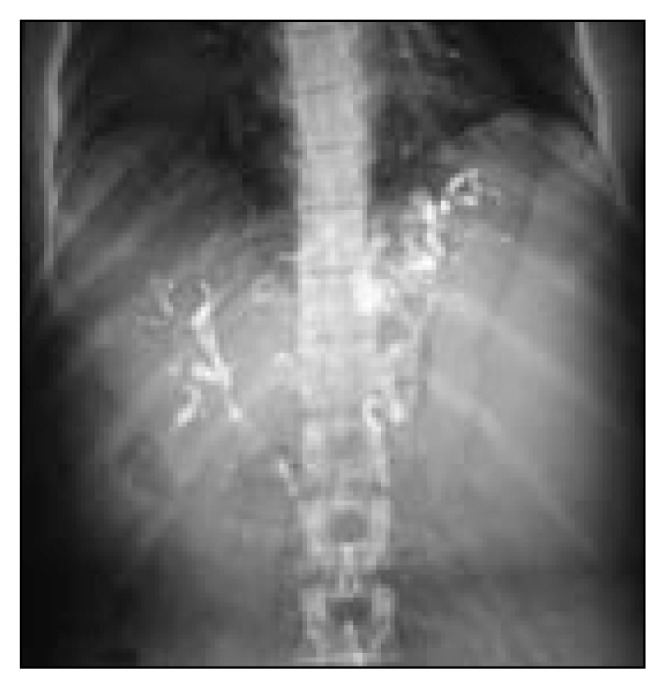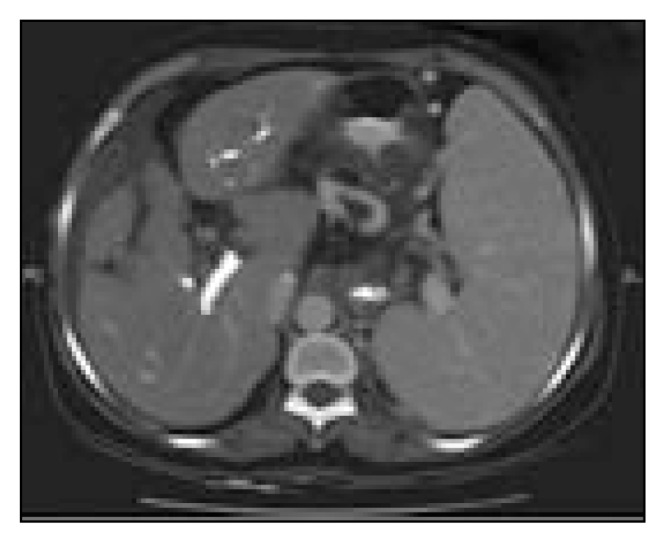To the Editor: The tissue adhesive N-butyl-2-cyanoacrylate (Histoacryl, Trihawk International, Montreal, Canada) is a well-known and effective modality for treatment of gastric varices secondary to portal hypertension of various causes. It has been used safely in many centers for up to 20 years.1,2 Nonetheless, in a minority of cases, its use has been associated with adverse effects like portal vein thrombosis. We report on the management of a secondary bleeding complication by placement of a transjugular intrahepatic portosystemic shunt (TIPS).
A 41-year-old woman was referred to our hospital with esophageal and gastric varices secondary to liver disease due to bilharziasis. She had multiple episodes of upper gastrointestinal bleeding. Esophagogastroduodenoscopy identified two esophageal and three gastric varices with evidence of hypertensive gastritis. A total volume of 2.5 cc of cyanoacrylate mixed with Lipiodol in a 1:1 ratio was injected at three different sites in the gastric varices. The patient started complaining of severe central abdominal pain, associated with generalized tenderness and rigidity 30 minutes after the procedure, but was hemodynamically stable. A plain abdominal radiograph obtained immediately showed no evidence of visceral perforation, but there was radio-opaque material widely spread in the distribution of the portal vessels (Figure 1). A CT scan of the abdomen showed multiple areas of dense material in the vessels of the upper abdomen, including the portal vein and its intrahepatic branches, as well as the splenic, splenorenal collaterals, and renal and cardinal veins. Thrombosis of the portal and splenic veins was also seen (Figure 2). Ultrasound Doppler showed hyperechoic material in the portal vein with turbulent blood flow in keeping with thrombosis. The superior mesenteric vein was patent.
Figure 1.

Abdominal radiograph showing dense radiopaque material involving the portal venous circulation of both hepatic lobes.
Figure 2.

Abdominal CT showing dense material in the right portal vein and a branch of the left portal vein. Splenomegaly and ascites are also present.
The patient responded to analgesia, her symptoms disappeared completely after 7 days, and she was discharged home. The patient was readmitted 5 months later with another episode of upper gastrointestinal bleeding. A repeat CT scan and hepatic ultrasound images showed some resolution of the portal thrombosis. The patient underwent placement of a TIPS. After placement, the patient did well without further bleeding.
Histoacryl injection in the treatment of acute gastric variceal bleeding is safe and cost effective when used according to recommendations, which call for a small volume (<3 mL in total and <1 mL at each site) of Histoacryl and Lipiodol in a 1:1 ratio.3 Nevertheless, the endoscopist must be alert to potential immediate complications like abdominal pain, fever, impaction of the injected needle, distal embolization and acute thrombosis or late complications like venous thrombosis secondary to gastric cyanoacrylate injection.4,5 Initial hemostasis with this modality of treatment can be achieved in over 90% of patients,2 obliteration of gastric varices can be achieved in 100%,7 but rebleeding can occur in about 10%.6
In comparison to a TIPS, Histoacryl injection therapy has no significant difference in terms of survival rate. It is relatively safe, has comparable rates of severe esophagogastric variceal bleeding8 and is more cost effective.9 To our knowledge, this is the first report of a TIPS placement to rescue a patient with major complications following administration of Histoacryl injection.
References
- 1.Ogawa K, Ishikawa S, Naritaka, et al. Clinical evaluation of endoscopic injection sclerotherapy using n-butyl-2 cyanoacrylate for gastric bleeding. Journal of gastroenterology and hepatology. 1999;14:245–250. doi: 10.1046/j.1440-1746.1999.01842.x. [DOI] [PubMed] [Google Scholar]
- 2.Akahoshi T, Hashizume M, Shimabukuro R, et al. Long-term results of endoscopic Histoacryl injection sclerotherapy for gastric variceal bleeding: a 10 year experience. Surgery. 2002;131:S176–181. doi: 10.1067/msy.2002.119501. [DOI] [PubMed] [Google Scholar]
- 3.Huang Y, Yeh H, Chen G, et al. Endoscopic treatment of bleeding gastric varices by N-butyl-2-cyanoacrylate (Histoacryl) injection: long-term efficacy and safety. Gastrointestinal Endoscopy. 2000;52(2):160–7. doi: 10.1067/mge.2000.104976. [DOI] [PubMed] [Google Scholar]
- 4.Shim C, Cho Y, Kim J, et al. A case of portal and splenic vein thrombosis after Histoacryl injection therapy in gastric varices. Endoscopy. 1996;28:461. doi: 10.1055/s-2007-1005514. [DOI] [PubMed] [Google Scholar]
- 5.Hwang S, Kim H, Park S, et al. N-Butyl-2-Cyanoacrylate pulmonary embolism after endoscopic injection sclerotherapy for gastric variceal bleeding. Journal of computer assisted tomography. 2001;25(1):16–22. doi: 10.1097/00004728-200101000-00003. [DOI] [PubMed] [Google Scholar]
- 6.Dhiman RK, Chawla Y, Taneja S, et al. Endoscopic sclerotherapy of gastric vericeal bleeding with N-butyl-2-cyanoacrylate. J Clin Gastroenterol. 2002;35:222–227. doi: 10.1097/00004836-200209000-00005. [DOI] [PubMed] [Google Scholar]
- 7.Sarin SK, Jain AK, Jain M, Gupta R. A Randomized controlled trial of cyanoacrylate versus alcohol injection in patients with isolated fundic varices. Am J Gastroenterol. 2002;97:1010–1015. doi: 10.1111/j.1572-0241.2002.05622.x. [DOI] [PubMed] [Google Scholar]
- 8.Noh du Y, Park SY, Joo SY, Park CH, et al. Therapeutic effect of the endoscopic N-butyl-2-cyanoacrylate injection for acute esophagogastric variceal bleeding: comparison with transjugular intrahepatic portosystemic shurt. Korean Journal of Gastroenterology/Taehan Sohwagi Hakhoe Chi. 2004 Mar;43(3):186–95. [PubMed] [Google Scholar]
- 9.Mahadeva S, Bellamy MC, Kessel D, et al. Cost-effective of N-butyl-2-cyanoacrylate (histoacryl) glue injections versus transjugular intrahepatic portosystemic shunt in the management of acute gastric variceal bleeding. American Journal of Gastroenterology. 2003 Dec;98(12):2688–93. doi: 10.1111/j.1572-0241.2003.08769.x. [DOI] [PubMed] [Google Scholar]


